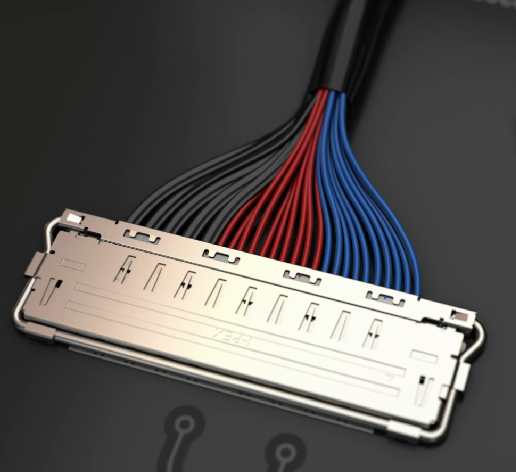Low-Speed Cable Assemblies in Enterprise Applications
As data rates increase, servers are using more cable assemblies. High-speed cables are the main driver, as PCBs can no longer “go the distance.” But low-speed cable assemblies continue to be important. Low-speed assemblies are still commonly used for power distribution, low-speed signals and auxiliary lines. Low-speed assemblies have few industry standards to define them, whereas high-speed signals have very active standards committees. Server density is increasing, as is power consumption and heat output. With or without a standard, all cable assemblies need to minimize bulk size so that the server system is both easy to assemble and has unobstructed air flow.
Low-speed cables, and short run high speed cables have the benefit that they can use smaller wire gauges (with obvious exceptions for power, of course). Smaller gauge wire requirements enable higher density connectors as well as flex circuit options. Smaller conductors allow higher density interconnect, reducing system space for routing and cable assembly terminations.
Contents :
Highly routable cable assemblies with tight bend radius
CABLINE Series connectors accept multiple wire types
CABLINE-CA IIF is for FPC assemblies, and mates to standard CABLINE-CA II receptacles
Highly routable cable assemblies with tight bend radius
Flexibility is a benefit for internal cables, high-speed and low-speed, as is low profile. Routing cables along the edge, between memory and the chassis wall is a great use of space. The ability to make tight radius turns reduces the volume consumed by the cable, even allowing corners of the chassis to be utilized. Click to see video showing I-PEX assemblies in servers.
If assemblies are not flexible, they may require a large bend radius, and take up more space as a result. Sometimes cables need to make a change along two axes, up and to the left, for example. Flat cables can have difficulty with a two axis change, requiring multiple folds, where a bundle would accommodate a change more easily, simply by twisting. A truly versatile connector system will allow for flex circuits, discrete wire, and high-speed impedance controlled wire. USB or Ethernet are sometimes run as access interfaces. They can be routed along with low-speed lines.
CABLINE Series connectors accept multiple wire types
 The front panel is one area in servers where low-speed cable assemblies are needed. The front panel will present status lights, small displays, and sometimes I/O, such as USB. A cable assembly for a low-resolution front panel display will have several discrete wires, and possibly a couple of pairs of high-speed wires. Small front panel LCD displays can be located anywhere along the front of the chassis, and are sometimes located in the mounting ear area. This is the area located immediately in front of the rack post. There can be a lot of sheet metal going into these areas, since the server will be anchored there. With limited space left over for cable, fine pitch assemblies are ideal for threading through the available space.
The front panel is one area in servers where low-speed cable assemblies are needed. The front panel will present status lights, small displays, and sometimes I/O, such as USB. A cable assembly for a low-resolution front panel display will have several discrete wires, and possibly a couple of pairs of high-speed wires. Small front panel LCD displays can be located anywhere along the front of the chassis, and are sometimes located in the mounting ear area. This is the area located immediately in front of the rack post. There can be a lot of sheet metal going into these areas, since the server will be anchored there. With limited space left over for cable, fine pitch assemblies are ideal for threading through the available space.
Low Profile, Miniaturization Applications
Micro-coaxial and discrete wire assemblies are available in extremely low profile systems. From high-speed to low-speed, these assemblies provide low profile options to save valuable space inside of servers. Many of these systems are used in drones, VR equipment and laptops, where space saving and weight reduction is at a premium. I-PEX Micro-Coaxial and Discrete Wire Connectors
I-PEX has a broad offering of fine pitch I/O connectors. I-PEX CABLINE®Series includes a variety of centerlines and mating orientations. They can terminate discrete wire, shielded wire, impedance controlled micro-coaxial cable, twin axial cable, and even has options for flexible printed circuit (FPC). If an application requires high speed, then high speed cable should be chosen, along with impedance control. Low speed cable assemblies can use less expensive cable. The CABLINE connectors are capable of high speed signaling, but the cable determines the performance of the end to end link.
For example, the CABLINE®-VS Micro-Coaxial Connector is a 0.5 mm pitch system, available in 20 to 50 positions. It uses a right angle board mount receptacle, and a straight plug, resulting in a parallel-to-board interface. Termination options are discrete wire, shielded wire, micro-coaxial wire and twin axial wire. There is even a plug version that can accommodate FPC. CABLINE®-VSF All of these termination options share the same board mount receptacle. FPC is a stand-alone assembly option, in that the assembly is only FPC. The wire options can be intermixed into a single assembly. It is common to have some higher speed lines mixed into a discrete wire assembly. If high-speed lines are required, micro-coax can be differentially driven for differential signaling. Connector shielding options are also available, providing 360-degrees of shielding, which is ideal for limiting EMI.
CABLINE®-CA IIF is for FPC assemblies, and mates to standard CABLINE®-CA II receptacles
 I-PEX has decades of experience with fine pitch cable assemblies and connectors. Contact us and see how we can assist you in tailoring a solution that meets your system design needs.
I-PEX has decades of experience with fine pitch cable assemblies and connectors. Contact us and see how we can assist you in tailoring a solution that meets your system design needs.
